The past year has been a challenge for anyone growing plants - farmers and gardeners alike.
2012 began with a drought and ended as one of the wettest on record and then we had a particularly cold, wet winter.
Crops in the field didn’t germinate properly and then lots of winter-standing crops, such as winter wheat and oilseed rape, were waterlogged and died. Lots of fields have huge bare patches where the ground doesn’t drain very well and many farmers simply gave up with the crop, ploughed it in during spring and sowed something that would produce a crop in the same year.
There are lots of fields of peas and lots of sweetcorn being grown. There’s an immense field of corn just south of Huntingdon, which I pass on the train each morning, and right now (late August) it’s standing really tall and lush with the male flowers at the top of the plants fully rampant. David, a farmer who lives in our road, ploughed up some of his oilseed rape and replaced it with linseed, which he says has done quite well.
Challenges facing farmers are much more demanding than my problems in the garden., but the weather has influenced my choices.
This year, I decided not to grow any salad crops because I’ve done quite badly with them. Between the weather and the dogs, last year was really poor and this year (as regular readers will know) there was a challenge to grow a good crop of sunflowers for Max and Inna’s wedding. A large part of the border between ours and my sister’s garden was given over to sunflowers. I had a tall variety called Prado Yellow, a mid-range size called Choco Sun and Little Dorrit, a dwarf.
For cut flowers, we used secondary flowers on the tall and dwarf plants. The medium-sized ones, even though the plants themselves were not too tall, had absolutely enormous flower heads - 8-10 inches across - and were totally unsuitable for cut flowers. Also, they didn’t have many secondary flower heads, so not really much use. They didn’t even look that good in the garden because they held their huge flowers heads downwards so they couldn’t be seen very well. I shall not grow them again, but their one redeeming feature is that they seem to have set seed very well, so I’ll just leave them to dry and mature so the birds can pick the seed from the heads during the late summer and autumn.
I’ll do the same with the other, remaining, sunflowers although they are (and have been) giving us a better show. I’d fenced off the border where they’re growing with wire netting to discourage the dogs, but it’s meant that we’ve not really been able to get in and weed. Margaret spent some time this Sunday getting out the larger weeds and it’s made a big difference.
This is the first year I’ve kept dahlia tubers over winter. I’d bought a dwarf variety and two taller varieties last year and overwintered the tubers in the garage. Previously, when I’ve grown dahlias, I’ve left them in the ground and during a mild winter they get by quite well and sprout good and strong the next year. The past few hard winters have done for the dahlias (and the agave) and the wetter conditions have also encouraged slugs, who think there’s nothing more tasty than a young dahlia shoot. I think they are often eaten even before they break through the ground, so you can’t be certain whether the frost has killed them or the slugs. Well during the winter of 2012-13 mine were dried and kept in boxes in the garage. It worked well: I checked them a couple of times, removed some soil (and the odd slug) from the tubers as they dried and then, later in the winter, moistened them to prevent them from drying out too much. The garage is frost-free, but possibly a little too warm.
I planted them first in pots in the summerhouse to give them a slug-free start and then in the garden with a good ball of compost around the tubers. The dwarfs have been a major disappointment, they’ve had lush foliage all year (quite an attractive dark green) but the flowers have been really poor and I think that one plant has completely failed to produce any flowers so far. The main reason I grew them was for the flowers (of course) but also as part of a plan to plant flowers that would attract bees and other nectar-loving insects. Like the other dahlias, they are a single variety and when they have flowered, they haven’t proved that attractive to bees. The taller ones have been better. They’re flowering profusely now and they are attracting bees. One, in particular, is a real magnet and bees will often sit on its flower head for 5-10 minutes. We see the same in the gourd flowers, which are spectacular, large, yellow trumpets that last only for a day. Bees get inside, right down into the flower, and almost seem to become inebriated on the nectar.
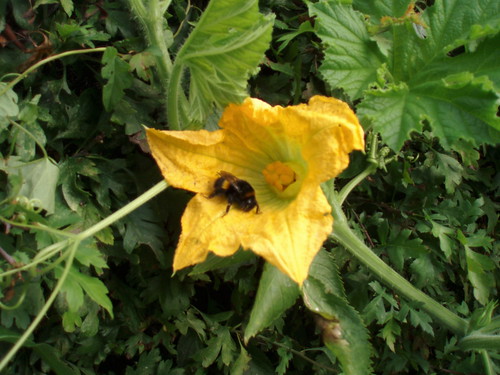 |
| Bee on gourd flower. They stay there for ages and almost seem drunk on the nectar. |
The gourds are something of a labour of love - Margaret’s favourite thing in the garden. Over the years, we’ve honed our method of growing them. We now put them in pots alongside the hedge and encourage them to climb along the hedge. This saves space and allows the fruit to hang clear of the ground so it doesn’t rot.
Last year, I saved my own seed and it worked well in that there was a good germination rate, but we didn’t really get the same variation and variety in the fruit. There were only three types of fruit and the predominant one was like a large, pale green pear - not massively attractive, although they did look good when varnished and glittered up for Christmas.
This year, I bought three varieties from Thompson and Morgan - a mixed packet, some swan-necked gourds and some bishops’ hats. We shared the seed with Lucy, Sam’s wife, who introduced us to gourds having grown them in Switzerland when she lived there with her parents for a short period. There has been some friendly competition this year to see who gets the best fruit. Lucy has the advantage of a conservatory for getting the seed off to an early start, but their garden space is restricted and her ‘evil’ plan is to grow a crop in her sister’s garden.
So far, we have some interesting shapes: There are a couple of monster-sized pale pears (like the ones I had last year from my own seed), some bright green and yellow fruits and some yellow-green, ribbed fruits which should look quite good. The swan necks are disappointing. I only managed one plant from my allocation. They’re quite attractive, but the twisty ‘swan neck’ has completely failed to develop. The plant set three of them and no more (so far). The bishops’ hats are doing better, but are a bit late. I think I have three of those, but they produced lots of male flowers to start with and only now are producing fruit. There are about four developing.
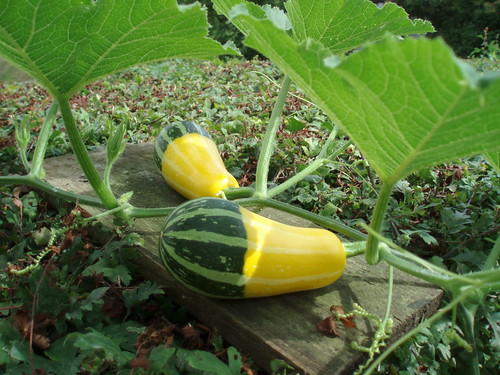 |
| These have run to the top of the hedge. The plank stops the thorns spoiling the gourd. |
I’ve allowed the gourds to climb up the hedge and onto the top, so we’re placing small off-cuts of planks under those to stop them being marked by the thorns. A couple of plants have decided the top of the hedge isn’t close enough to the sun and have managed to climb into trees. A bishop’s hat at the bottom is heading up the oak tree and one half-way down the garden got into the acer brilliantissima. It developed a couple of large fruit, which hung down from the tree looking very odd and we also had an acer which seemed to have sprouted large yellow flowers. Sadly, it ended in disaster. We had a really windy day on Saturday and the swaying of the branches snapped the stem between hedge and tree. The gourds do have some built-in flexibility. Their tendrils grip a point and then coil like a spring which helps given them some ‘bouncebackability’ but this was a sway too far.
There’s perhaps another six weeks growing time before reducing hours of daylight and colder nights check their growth. I hope we get a decent number of bishops’ hats and perhaps the severed gourd can sprout and make enough growth to produce some more fruit.
Nasturtiums are a mixed blessing. They are cheap and easy, they provide early colour, cover bare ground quite well and the edible flowers provide colour in a salad. However, they suffer badly from black-fly infestation and are eaten by caterpillars. Blackfly has been a problem this year and has covered nasturtiums, dahlias and roses. I don’t think I’ve seen one ladybird in the garden (which might explain why the blackfly are so prolific). The dearth of ladybirds is odd because they are lots of insects about - plenty of bees, wasps enough to spoil a breakfast of marmalade on toast, I’ve been bitten all over by mossies and there has been a spectacular display of dragonflies every day for the past fortnight. Come on ladies, get your act together, let’s be ’avin’ you!
Lots of my nasturtiums are self-seeded, but I did buy a variety which was claimed to be especially free-flowering and vibrantly coloured. They were a lovely show, but are now at that stage of the season when their leaves are yellowed from blackfly or stripped by caterpillars. Actually, I think having caterpillars eat your nasturtiums is not a bad trade-off for some nice butterflies so I don’t try to destroy the caterpillars and I leave the stripped plants in place. The plants look dreadful for a while, a mass of bare twisted stems, but then they come back with new leaves and a late show of flowers in autumn. It’s almost as if nature gives them a mid-season pruning. On one plant I counted three different types of caterpillar, all enjoying lunch. Tom put a macro lens on his camera and shot this video of Large White caterpillars on the nasturtiums. Later, he took this video of plants in the garden.
Last year, Margaret wanted me to grow Chinese lanterns so she could use them for dried flowers. I got some seed, but had a real job to get it to germinate in the cold, wet conditions. I did get about four plants and these went out in the garden. My sister also gave me a small offcut from one of hers. They have proven problematic, firstly to find somewhere to put them and then to keep them through the winter and stop the dogs from trampling them. They disappear during the winter, so it’s easy to think they’ve been lost (or forget where they are and plant something else). The upshot is that I have three plants which I think are Chinese lanterns, but may be unrelated weeds which have sneaked into my pots. I have some small flowers, but I’m waiting for a lantern to appear.
I had tried several times to germinate rudbeckia when we lived in Warrington and when we first came to Thorney, but had no joy. So a couple of years ago, I bought two plants from the garden centre in Helpston and they have been very good, flowering for a long period and with lovely, rich yellow flowers. They also attract bees. One is looking a little swamped by other plants this year, so I need to sort that for 2014, and the other had thrown out lots of side shoots which were looking a little untidy so I dug it up in spring and divided it. I wasn’t as skilled at this as I should have been, but I now have three good plants from the original one.
Margaret’s dad was always very proud of his fuchsia plants, which he used in hanging baskets. I remember thinking how much more spectacular they were compared to the small flowers on a fuchsia in my dad’s garden in Manchester Road. That was a small tree rather than a hanging-basket plant and had been planted by my uncle Tom, a keen gardener many years earlier (probably before the First World War).
When we lived in Warrington, I successfully took around three cuttings from the shrub and I brought one with me when I came to Peterborough. It has been planted in the big border for many years where it has hung on at the back, under the tulip tree somewhat starved of light and in danger of being swamped by vinca (periwinkle) coming through from my sister’s garden. It has survived every winter and always managed a few flowers, but they’ve barely been seen. So last year, when I cut down the tulip tree, I moved the fuchsia to the other border by the gate. It’s still in the shade of a tree (the acer drummondii) but has more light and has grown quite nicely this year. It’s not bad for the scion of a shrub that’s more than 100 years old.
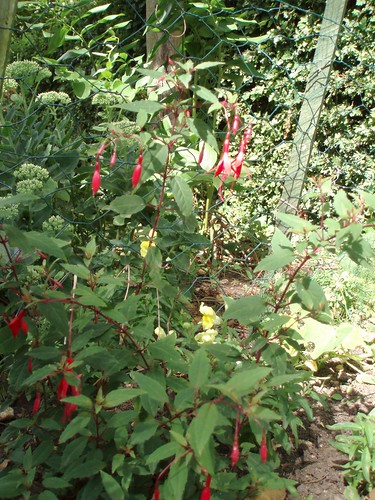 |
| Fuchsia grown from a cutting from a very old bush. The flowers are very small and unspectacular by modern standards. |
Cornflowers are great for attracting bees and have been an important part of my planting for the past three or four years. The bees (and other insects) absolutely love them and if you remove the dead flowers to stop them setting seed, they keep going all through the summer. Next year, I’m going to grow them in little patches scattered through the border, protected from dog-trampling by wire netting like infantry squares on a Napoleonic battlefield.
Our blackcurrant and redcurrant bushes are now into their third year and have reached a stage where we should be getting a decent crop. We had about 1lb off them in year 1, about 4lbs last year and about 10lbs this year (off the blackcurrants). I read that a mature bush should have about that on the one plant, but ours are not in a perfect position regarding light and also are planted quite close together. This year, they put on some good growth in the spring and the flowers were slightly later setting (due to the cold spring). Also, we netted the plants this year when the currants began to ripen. Last year, I think the birds snaffled a pound or two of fruit. The redcurrant (we have just one bush) was a bit of a disaster. I had wanted to pick the fruit in bunches so we could freeze it and use it to garnish sweet dishes and puddings. There was a decent crop on the bush, but just as the bunches of currants were all ripe and ready to pick, the birds beat us to it and took the riper ones off the bunch. It’s quite hard to get up earlier than a bird, so I think we’ll just have to let them have their share (the lion’s share).
A year after I planted the blackcurrants, I put in a couple of gooseberry bushes. It was the first time I’d grown gooseberries. Last year, we had a handful of fruits, but this year there was a really good crop considering the bushes are only in their second year. I think we had almost 4lbs and Tom made a pie with the first batch, which was quite nice. I deserved a piece of pie after pricking my fingers picking the fruit (gooseberries are full of long thorns). It is a satisfying crop to harvest, though; the fruit is much larger than blackcurrants.
At the same time I put in the blackcurrants, I also planted two Tayberries. These are thornless briars that produce a fruit that’s supposed to be halfway between a blackberry and a raspberry.They were a little more tart than I’d hoped and last year was a disappointing crop with most of them rotting on the plant. This year, the plants were bigger, they had a good crop of flowers and plenty of fruit set. We had a few pounds of fruit, but (like last year) so much of it just rotted on the briars. I thought it would make more sense to root out the Tayberries and replace them with thornless blackberries. We went to Crowland and selected two plants of a variety called Waldo. They were half-price, so we thought we’d got a bargain, but we also liked a variety called Oregon Thornless, which had really attractive foliage.. While we were there, Margaret snaffled a dark red gooseberry and said it was absolutely delicious - very sweet - it was tempting to swap our tart variety for a couple of those. When we got home (as often happens) we had a brainwave. Why didn’t we replace the dead clematis and the out-of-control honeysuckle on the patio with three Oregon Thornless blackberries. The foliage would look nice and we’d get fruit as a bonus. That’s exactly what we did, so we now have five blackberry plants and come 2015, we should be knee deep in them.
A few years ago, Margaret’s brother Harvey gave us a hydrangea that we’d grown from a cutting. It’s done quite well sitting in a pot and is now a size-able plant and is in full flower right now.
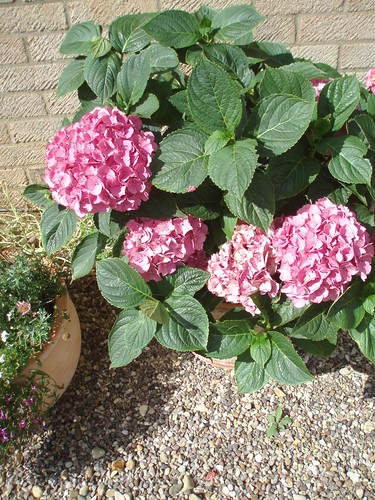 |
| The hydrangea from Harvey is thriving |
One thing I am trying for the first time is Butternut Squash. My friend Andrew Knights said they won’t grow outdoors in the UK. He’d tried on his allotment a few years back and they had been a disaster. I chose Harrier from Thompson and Morgan, a variety that was recommended for growing in the UK. They germinated well and I planted them in pots to be grown against the side of the house where they would be most sheltered. They have made good growth, they’re quite compact and so far have a couple of fruits on each plant. This has been a good summer, so I don’t think that’s a brilliant performance. There are more fruits setting, so it will be interesting to see what size we get and how many; also how well they ripen (they are still quite green).
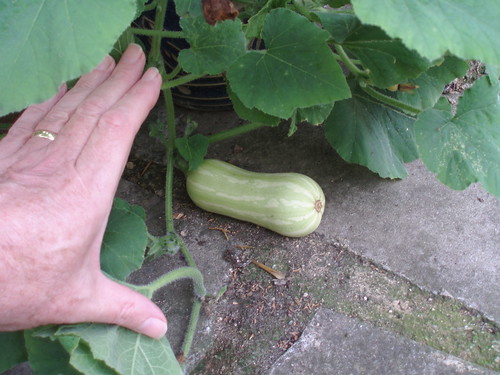 |
| Butternut squash fruit is forming, but needs to get cracking if it is to ripen fully. |
No comments:
Post a Comment